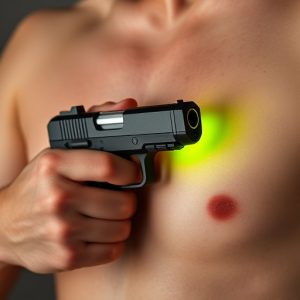Guiding Your Choice: An In-Depth Review of Stun Gun Efficacy and Safety
Stun guns are self-defense tools that deliver high-voltage shocks to temporarily incapacitate an at…….
Stun guns are self-defense tools that deliver high-voltage shocks to temporarily incapacitate an attacker by causing muscle spasms and disorientation. They require direct contact with the target's skin for optimal effectiveness, though some advanced models can penetrate through clothing, albeit with varying degrees of success depending on fabric thickness. Proper training is crucial for effective use, as the devices must make skin-to-skin contact to function correctly. When choosing a stun gun, users should consider models with 'drive-stun' capabilities that can deliver shocks from a distance, as well as their amperage and safety features. Higher amperage is beneficial for a more potent shock, while safety mechanisms like automatic shut-offs prevent misuse. Selecting the right stun gun involves balancing these factors with personal safety needs and adhering to legal guidelines for self-defense use.
When considering personal safety devices, stun guns stand out as a non-lethal option for self-defense. This article delves into the effectiveness of stun guns, addressing frequently asked questions such as “Does a stun gun have to touch skin?” We explore their operation and the science behind how they incapacitate assailants without causing permanent harm. Additionally, we evaluate various stun gun models by examining their features, power output, and safety aspects. Understanding these elements is crucial for anyone looking to make an informed decision on whether a stun gun is the right self-defense tool for their needs.
Understanding Stun Guns: Effectiveness and Skin Contact Requirements
Stun guns are electronic devices designed for self-defense, delivering a high-voltage, low-ampere electrical shock to an attacker. The effectiveness of a stun gun is contingent upon several factors, including proper usage and adequate skin contact. Unlike projectile weapons, stun guns must be in direct contact with the target for them to function effectively. The current from a stun gun is intended to disrupt the nervous system of an assailant, causing muscle spasms and temporary paralysis. It’s a non-lethal option for personal security that can provide a critical window of escape for the user.
When considering the use of a stun gun, it’s crucial to understand its skin contact requirement. Contrary to popular belief, does a stun gun have to touch skin for it to work? The answer is affirmative; the device must make direct contact with the individual’s skin to deliver its charge effectively. This is because the conductive prongs or electrodes on the stun gun require a path to complete the electrical circuit. Without skin contact, the device cannot adequately transmit the electrical charge, diminishing its ability to incapacitate an attacker. Users should ensure they are trained in the correct handling and deployment of stun guns, as improper use can lead to ineffective self-defense outcomes. Understanding these requirements is essential for anyone considering a stun gun as a component of their personal safety strategy.
The Science Behind Stun Guns: How They Work and Their Impact on the Human Body
Stun guns are electroshock weapons designed to incapacitate an attacker by delivering a high-voltage, low-ampere electrical charge. The effectiveness of a stun gun is contingent upon its ability to disrupt the muscle function of an adversary. When activated, the device emits an electric current that rapidly depolarizes the muscles, causing involuntary contractions that can lead to disorientation and temporary immobilization. This response occurs due to the electrical impulses interfering with the neural signals responsible for muscle control. The intensity of the shock is such that it overwhelms the body’s ability to regulate its own muscle activity, resulting in a state where the individual can no longer maintain conscious control over their movements.
The impact of stun guns on the human body is a subject of both scientific inquiry and ethical debate. It is a common misconception that stun guns must come into physical contact with the skin to be effective. In reality, some models are designed with probes or darts that can deliver an electric shock through clothing, although the efficacy may vary depending on the thickness of the barrier. The electrical charge, once it breaches the skin’s resistance, disrupts the body’s nervous system by stimulating nerve cells and muscles beyond their normal threshold, causing a loss of balance and motor control. This non-lethal weapon is intended to neutralize an assailant without causing permanent harm, but the extent to which it can be used safely and ethically remains a topic of considerable discussion among law enforcement professionals, legal experts, and human rights advocates. Understanding the science behind stun guns is crucial for users to employ them responsibly and legally within the bounds of self-defense and public safety.
Factors to Consider When Evaluating Stun Gun Models: Features, Power, and Safety Concerns
When assessing various stun gun models, it’s crucial to examine their features, power output, and safety considerations. The efficacy of a stun gun often hinges on its design and capabilities. A key feature to evaluate is whether the device requires direct contact with the skin to deliver its shock, as some models offer drive-stun capabilities where the stun gun can incapacitate an assailant without having to touch them. This feature can be particularly advantageous in situations where maintaining distance is critical for personal safety. Additionally, the power of a stun gun is quantified by its amperage and milliampere (mA) rating; higher ratings generally equate to stronger shocks that are more likely to incapacitate an attacker. However, it’s important to consider the safety features built into the device. Features such as safety switches that prevent accidental discharges, LED lights for visibility during deployment, and a durable construction that withstands environmental factors are essential in ensuring the stun gun is both effective and safe to use. Moreover, some models come with additional safety measures like an automatic shut-off feature to prevent prolonged exposure, which is important for both self-defense and avoiding any harm to oneself or others. Evaluating these aspects will help users choose a stun gun that meets their personal safety needs while adhering to legal guidelines regarding the use of such devices.


